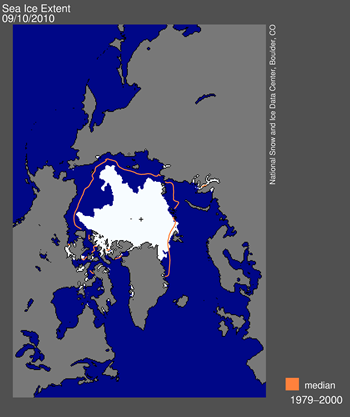http://nsidc.org/arcticseaicenews/2010/091510.html
Arctic sea ice appears to have reached its annual minimum extent on 10 September. The minimum ice extent was the third-lowest in the satellite record, after 2007 and 2008, and continues the trend of decreasing summer sea ice.
Overview of conditions
On September 10, 2010 sea ice extent dropped to 4.76 million square kilometers (1.84 million square miles). This appears to have been the lowest extent of the year; sea ice has now begun its annual cycle of growth.
The 2010 minimum ice extent is the third-lowest recorded since 1979. The 2010 minimum extent is 240,000 square kilometers (93,000 square miles) above 2008 and 630,000 square kilometers (240,000 square miles) above the record low in 2007. This is 340,000 square kilometers (130,000 square miles below 2009. The 2010 minimum is 1.95 million square kilometers (753,000 square miles) below the 1979 to 2000 average minimum and 1.62 million square kilometers (625,000 square miles) below the thirty-one-year 1979 to 2009 average minimum.



One could as easily have said: It continues the trend of increasing sea ice since 2007!
Sept 2011 will be higher than Sept 2010 for minimum extent. Question is, how much. Is there anyone saying it will be lower? Does La Nina have a big effect on Sea Ice?
How did piomas compare to pips in their forecast with these figures?
I expect the minimum Arctic sea ice extent in 2011 to be near or below that of this year because the ice in the Beaufort and Chukchi seas in spring of 2011 will be almost exclusively first year ice. Unless we have an exceptionally weak Transpolar drift and subsequent suppression of ice export through Fram Strait this winter, the Laptev and East Siberian seas will also be covered by first-year ice, and even a good proportion of the central Arctic Ocean could well end up with first year ice. If the summer weather is near average, most of this first year ice will not survive. However, if the areas covered by first year ice in the spring of 2011 experience a highly anomalous (more than 2 SD from the mean) cloudy and cool June, like what happened in 1996, we might manage to end up with over 5 M km^2 of ice at the minimum…
Do you think they are confusing sea lice with sea ice? That would make more sense.